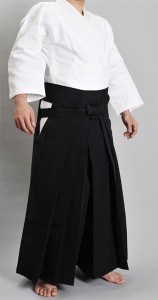The Aikido Gi or Aikidogi is a very peculiar form of uniform since it isn’t really born from the martial art it represents. That’s right – the Aikido gi isn’t really from Aikido. As a matter of fact, the whole concept of the gi doesn’t stem from Aikido. It doesn’t even stem from Karate; it comes from Judo.
A Brief Glimpse at the Origins of the Aikidogi
Aikido officially started circa 1937 when founder Morihei Ueshiba moved to Hokkaido. Prior to this he was heavily influenced by his friend and master, Takeda Sokaku, who focused primarily in the art known as Daito-ryu-aiki-jujutsu.
By 1937, however, Ueshiba began to move away from this traditional martial art and began focus on his own version of Aiki. His version focused heavily on throws and how to counter them. There was some level of striking but not as in-depth as in Karate. There was some level of grappling but not as in-depth as in Judo.
Aikido became the official name of his new art in 1942.
However, despite these advances, the school of Aikido borrowed heavily from other martial arts, particularly with the use of the uniform.
In traditional martial arts, learners only had a scroll to signify their advancement. Their master would sign the scroll, certifying that the student had studied a specific technique or had achieved a milestone. Without the scroll, there was no other way to know a student was advancing.
This is why Aikido adapted the gi from Judo.
The Judogi was a refinement of the traditional kimono, making it more ideal for grappling and for free movement. The Judogi was also thicker and heavier than a kimono because it had to be strong enough so it wouldn’t rip when someone grabbed on and threw their opponent.
In order to show advancement in skill and rank, the Judogi introduced the use of colored belts. White belts were used for the learners and black belts were used for the more advanced fighters.
Aikido instantly adapted these when it became an official martial art during the late 1930s and early 1940s.
There is No Formal Aikidogi
 If you were to shop online for an Aikido gi you’d be hard-pressed to actually find one. This is because traditional Aikido schools use either Karate gi or Judo gi. This is important to keep in mind because the two are slightly different in material and design.
If you were to shop online for an Aikido gi you’d be hard-pressed to actually find one. This is because traditional Aikido schools use either Karate gi or Judo gi. This is important to keep in mind because the two are slightly different in material and design.
The Karate gi is much lighter and also a bit looser. This makes it ideal for striker and for countering specific moves. However, Aikido is more about throwing an opponent so the light material for Karate isn’t often used. Instead, it is an alternative for younger children learning the basics of Aikido.
Judo gi is much thicker and heavier, particularly with the jacket or top. The pants need to stay light so that they do not restrict movement but the thicker jacket ensures it won’t rip. The added seams also give more material for fighters to grab onto, making it easier to throw an opponent.
In some places you may find specific keikogi (the generic term for these “combat kimono” uniforms) which is tailor-made for Aikido but this is very rare. The commonly accepted Aikido keikogi is a Judogi with only slightly shorter jacket sleeves, similar to a Karate gi.
One of the additions of Aikido to the pants is the inclusion of knee patches.
The Use of the Hakama
The Hakama is one of the most traditional clothing in Japanese culture. It was initially worn only by men but over the centuries it has also become a part of women’s clothing. Traditionally it is a type of formal clothing worn on top of the kimono.
In regards to Aikido, the Hakama worn is not the undivided version but the divided one which resembles wide, baggy trousers. The Hakama is often colored black and is worn on top of the traditional Aikido gi.
Not everyone practicing Aikido is required to wear the Hakama. Instead, this addition to the uniform is reserved solely for people within the higher ranking, particularly those who have achieved the dan ranking, signified by their black belt.
In some schools, only instructors are allowed to wear the Hakama. This made it easier for students to identify who were students and who were the instructors, especially in schools where there were many black belt achievers. Some students could have earned the black belt but only a few were allowed to wear the Hakama and partake in teaching.
The Aikidogi Belt
Like in many other martial arts, the belt is a significant part of the gi. It represents the level of skill and experience a person has. Unlike other martial arts, however, traditional Aikido only uses two colors: white for the kyu (grades) and then black for the dan (degrees).
It is only in Western schools that colored belts were used in conjunction with the Aikidogi to give a better sense of advancement. This practice also allowed students to gauge how far they were in their skills. These additional colors are not often used in Japan.
You can learn more about Aikido belts here.